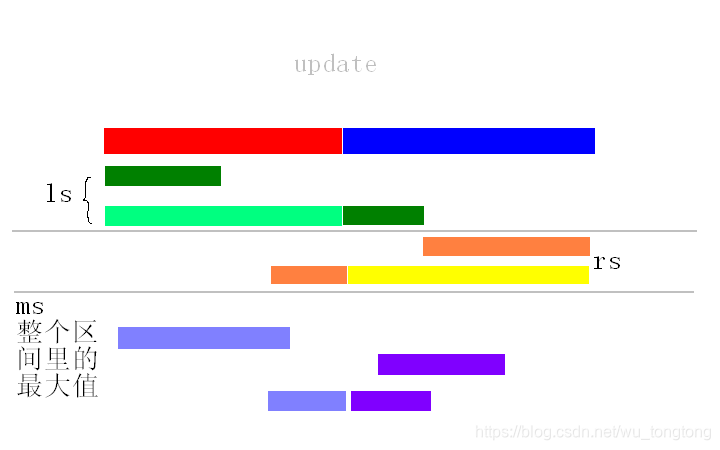这个故事是这样的:
在n年前,憨憨博主在参加省队集训的时候,第一次接触到了这个问题:区间最大连续子段和,
于是博主就开始一阵恶补,get了这种新技能
然而在夏季的一个宁静的午后,博主的CSDN突然接到消息通知,发现好心的大佬给我指出了我写的代码的不足,憨憨博主非常惭愧。。。
前端时间都在忙着大学的各种事项,没有抽出时间来修正这个错误
十一假期留校,突然想起来了我好像还有个大坑没有填,于是就上网查看了一下
发现竟然还有小伙伴在解决这一问题的时候引用的是我的blog。。。误人子弟啊~~
废话不多说,赶紧献上崭新的解题姿态~
(引用我原先blog的小伙伴也不用慌,我会把链接直接指向这篇blog的~)
首先,这个“区间最大子段和”是个什么玩意呢
题目给出 个数, 次操作,每次改一个值,或者询问区间 内最大的连续子段和
哎呦,感觉很像线段树的题目哦
毕竟我们是会用线段树求区间最大(小)值的
但是现在题目要求的是最大子段和,问题的难度就上升了一个数量级
线段树需要维护的是:
内的最大子段和
的区间和
内的紧靠左端点的最大子段和
内的紧靠右端点的最大子段和
困难就是, 和 询问 区间内的最大子段和
那我们一步一步来,从维护说起
的维护很常规,
有两种情况:
- 该区间内的 是ta左儿子的
- 该区间内的 是左儿子的 +右儿子的
同理, 有两种情况:
- 该区间内的 是ta右儿子的
- 该区间内的 是右儿子的 +左儿子的
而 有三种情况:
- 该区间内的 是左儿子的
- 该区间内的 是右儿子的
- 该区间内的 是左儿子的 右儿子的

void pushup(int bh) {
int lson=bh<<1;
int rson=bh<<1|1;
tree[bh].s=tree[lson].s+tree[rson].s;
tree[bh].ls=max(tree[lson].ls,tree[lson].s+tree[rson].ls);
tree[bh].rs=max(tree[rson].rs,tree[rson].s+tree[lson].rs);
tree[bh].ms=max(max(tree[lson].ms,tree[rson].ms),tree[lson].rs+tree[rson].ls);
}
那询问呢~
其实道理是一样哒
内的区间最大子段和分以下几种情况:
1.独立的存在于左儿子或右儿子中
2.左儿子的
+右儿子的
然而如果
在线段树中是一个节点(我们单独维护过),那我们直接
就好啦
下面给出完整代码
#include<cstdio>
#include<iostream>
#include<cstring>
#include<algorithm>
#define LL long long
using namespace std;
const int M=10000;
struct node{
LL s,ls,rs,ms;
}tree[M<<2];
void pushup(int bh) {
int lson=bh<<1;
int rson=bh<<1|1;
tree[bh].s=tree[lson].s+tree[rson].s;
tree[bh].ls=max(tree[lson].ls,tree[lson].s+tree[rson].ls);
tree[bh].rs=max(tree[rson].rs,tree[rson].s+tree[lson].rs);
tree[bh].ms=max(max(tree[lson].ms,tree[rson].ms),tree[lson].rs+tree[rson].ls);
}
void build(int L,int R,int bh) {
if (L==R) {
scanf("%lld",&tree[bh].s);
tree[bh].ls=tree[bh].rs=tree[bh].ms=tree[bh].s;
return;
}
int mid=(L+R)>>1;
build(L,mid,bh<<1);
build(mid+1,R,bh<<1|1);
pushup(bh);
}
void update(int x,int z,int L,int R,int bh) {
if (L==R) {
tree[bh].ls=tree[bh].rs=tree[bh].ms=tree[bh].s=z;
return;
}
int mid=(L+R)>>1;
if (x<=mid) update(x,z,L,mid,bh<<1);
else update(x,z,mid+1,R,bh<<1|1);
pushup(bh);
}
node askans(int x,int y,int L,int R,int bh) {
if (x<=L&&y>=R) return tree[bh]; //完全包含
int mid=(L+R)>>1;
node f1,f2,T;
T.s=0;
if (y<=mid) //全部都在左儿子
T=askans(x,y,L,mid,bh<<1);
if (x>mid) //全部都在右儿子
T=askans(x,y,mid+1,R,bh<<1|1);
if (x<=mid&&y>mid) { //询问区间被拆成两部分
f1=askans(x,y,L,mid,bh<<1);
f2=askans(x,y,mid+1,R,bh<<1|1);
T.s=f1.s+f2.s;
T.ls=max(f1.ls,f1.s+f2.ls);
T.rs=max(f2.rs,f2.s+f1.rs);
T.ms=max(max(f1.ms,f2.ms),f1.rs+f2.ls);
}
return T;
}
int main()
{
int n,m;
scanf("%d%d",&n,&m);
build(1,n,1);
while (m--) {
int typ,x,y;
scanf("%d%d%d",&typ,&x,&y);
if (typ==1) {
if (x>y) swap(x,y);
node ans=askans(x,y,1,n,1);
printf("%d\n",ans.ms);
}
else update(x,y,1,n,1);
}
//system("pause");
return 0;
}
Tip
第一次用VS写代码,有点小费劲
在上传代码的时候,不知道是CSDN的锅还是我的笔记本的锅
在复制粘贴的时候如果代码中出现空行就会导致我的blog内容全部丢失
所以花了好长的时间才完成了排版QwQ
后来发现是浏览器的问题,微软自带的浏览器(Microsoft Edge)对Markdown的兼容性不好,换成Chrome就OK啦
关于VS有自动格式化的问题
缩进排版什么的确实有
但是如果用Edge上传(复制粘贴),所有的排版就会全部乱掉,真的惨啊。。。
